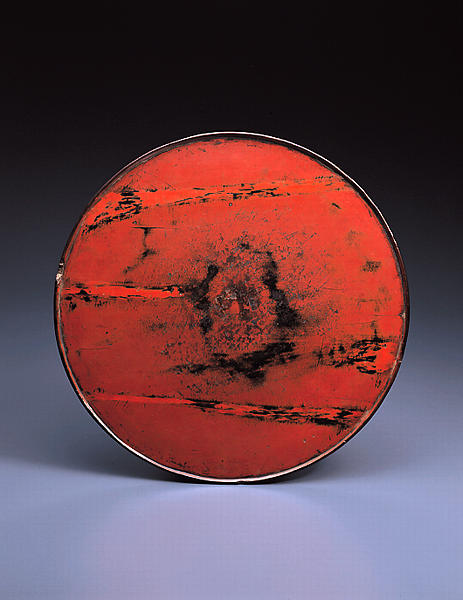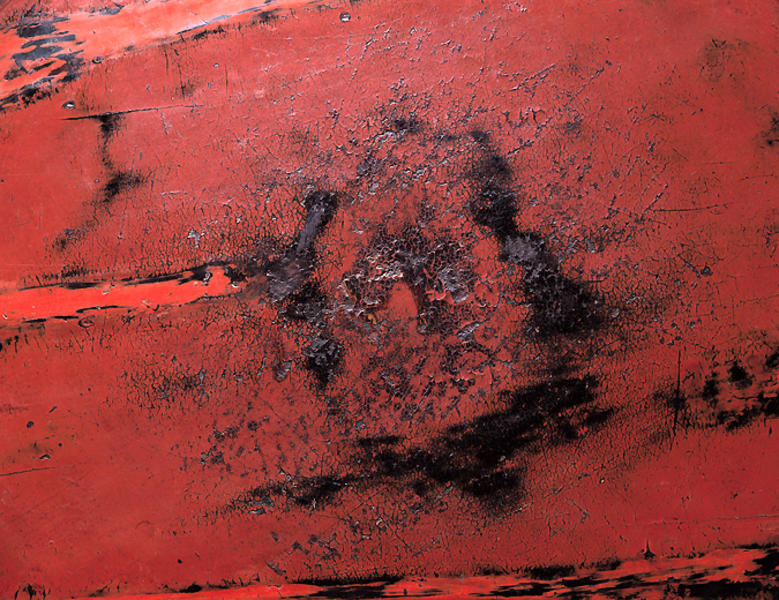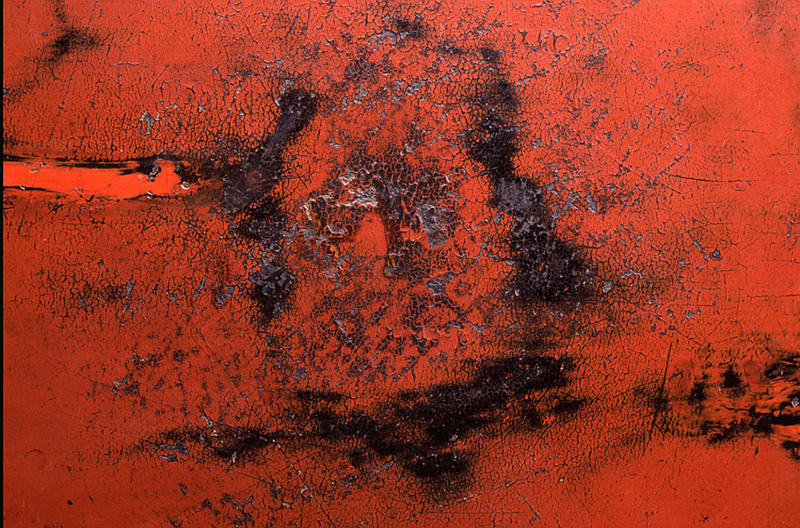二月堂練行衆盤(日の丸盆)
- 鎌倉時代
- 13c
- 木製(欅)朱漆塗
- H-1.8 D-44
- 所蔵
- 東大寺二月堂伝来 重要美術品
鎌倉時代 13世紀 永仁6年(1298)
高:1.8cm 径:42.3-43.2cm
例年3月(陰暦2月)に東大寺二月堂で厳修される修二会(お水取)の行法の際,練行衆(篭りの僧侶)が食堂で飯椀・汁椀・菜椀・木皿などの食器類をのせるために使用する盆。
十分に乾繰させた良質のケヤキ材から,円盤状素地を轆轤挽き成形,堅地に仕立てて総体に黒漆の地塗りを施したのち,線の立ち上がりを除く表面にのみ朱漆による上塗りを行って仕上げている。
円形の盤という単純明快な形のなかに,洗練された美を表現することは至難の業と言わねばならないが,使いやすく機能性に富んでいることが結局はそのものの造形性を高め洗練された美を形づくるのである。重厚なケヤキ板を材としながらいささかも武骨さが見られないのは,裏面の周縁部を面取りにして,縁造りを薄手にしつらえていることに起因するところが大きい。厚味を残す平滑な底面の造作においても,円形に浅く刳り込んでいることが重量の軽減に役立ち,しかも変形防止のうえでも効果を発揮しているのである。使う側の立場に立った作者の繊細な心配りが偲ばれるところである。
加うるに,置用した食器の底擦れや積年の手擦れ・払拭などによって自然に生じた黒地と上塗りの朱漆との美しい抽象文様が深い味わいを醸し出している。茶人が賞じ,数寄者が垂涎のものとして希求して止まないのも,数百年の歳月が作り出したこの巧まざる味わいにほかならない。
黒地のままの底裏をめぐって「二月堂練行衆盤廿六枚内永仁六年十月日漆工蓮□仏」の朱漆銘を記し,由緒,製作年が明らかなところから「永仁盆」と呼ばれて親しまれている。また,鮮やかな朱色の丸盆であるところから「日の丸盆」とも称される。当初は練行衆の数に合わせ二十六枚しつらえられたが,現存するのは重要文化財指定の十一枚の東大寺蔵品のほか,寺から離れた数枚が好事家の愛用するところとなっている。若干補修の部分も認められるが,これもその一枚。中央に「十一」と判読される番号が記されている。(河田)
お水取り
お水取り
奈良市東大寺二月堂の行事。3月1日から二七日(14日間)行われる修二会(修二月会)のなかの一行法で、3月12日(旧暦の2月12日)に行われる一行法。
深夜、呪師を先頭にした7人の練行衆が二月堂前の井屋の閼伽井戸で閼伽水(香水)を汲み堂に運ぶ。縁起によればこの水は、若狭の遠敷明神が二月堂の神々の勧請の時に遅れ、お詫びとして神の霊水を本尊に捧げられたもので、若狭から地の下を送られてくるという。
修二会は十一面観音に罪や過ちを懺悔する十一面悔過の法要。天平勝宝4年(752)に実忠によって始められたと伝えられる。
金銅香水杓
Catalogue Entry
Kamakura period, 13th century (dated 1298)
Red lacquered wood
Height, 1.8cm; diameter, 42.2-43.2cm
Every March, the second month in the lunar calendar, the Shunie rituals (commonly known as Omizutori) are held at the Nigatsudo, or literally 2nd month hall, of Todaiji. During these rituals, the rengyosyu (secluded monks) use a set of utensils in their refectory--rice and soup bowls, and dishes--which would have been placed on this type of tray.
Carved from a fully dried piece of high quality keyaki (zelkova) wood, the round form of this tray was shaped on a lathe, and then it was coated overall with a ground coat of black lacquer. With the exception of standing edges, the rest of the top surface of the tray was then coated with a top layer of red lacquer.
It goes without saying that it would have been extremely difficult to create a refined sense of beauty in such a simple circular form, but in any event, the sheer functional utility of this tray, its very form, in itself became a refined form of beauty. The carver was sure-handed as he planed the heavy sheet of keyaki wood, and the appearance of the wood grain on the back and the thinning of the edges contribute to its beauty, as the shallow, circular carving of the flat inner surface of the tray retains a sense of some weight, as it also effectively prevented warping.
These elements and others all give a sense of a carver creating a tray with a subtle understanding of its use.
The placement of eating utensils on the tray over the centuries has scratched and marred its surface, and these natural markings have created a particularly fascinating pattern of black undercoat revealed amidst the traces of the top coat of red. This effect that could only emerge after centuries of use was prized by tea masters and keenly sought after by collectors.
Circling the plain black lacquered back of this tray, an inscription in red lacquer clearly states the year of its production: "Nigatsudo Rengyoshu ban nijurokumai uchi Ei'nin rokunen ju gappi shikko ren? butsu?," or literally "one of 26 Nigatsudo ritual trays, 10th month 1298 (Ei'nin 6), lacquerer Ren butsu." The Ei'nin era date has led to the "Ei'nin tray" nickname for these trays, and its simple, red circular form has also led to another nickname, "Hinomaru," or red sun, trays. Originally, 26 of these trays were produced to correspond to the number of Rengyoshu priests, and at present 11 of these trays remain at Todaiji and have been designated Important Cultural Properties. In addition, several trays are no longer in the temple collection and have been scattered among a number of other collections. There are some traces of repair discernible on the present tray, but it would appear that this tray is one of the 26 trays, and the number "11" can be deciphered on its center. SK


